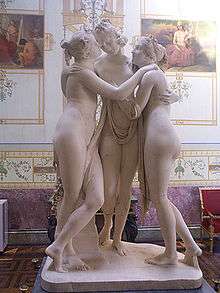Aglaea
| Look up Aglaea in Wiktionary, the free dictionary. |

Aglaea (/əˈɡliːə/) or Aglaïa (/əˈɡlaɪə/; Greek: Ἀγλαΐα "splendor, brilliant, shining one") is the name of several figures in Greek mythology, the best known of which is one of the three Charites or Graces.
As a Charis or Grace
Aglaea is the Greek goddess of beauty, splendor, glory, magnificence, and adornment.[1]
She is the youngest of the Charites or Graces, although Homer knew of a younger Charis or Grace named Pasithea ("Hallucination"). Aglaea is one of three daughters of Zeus and either the Oceanid Eurynome, or of Eunomia, the goddess of good order and lawful conduct. Her two sisters are Euphrosyne, the goddess of joy or mirth, and Thalia, the goddess of festivity and rich banquets.[2][3] Together they are known as the Three Graces, or the Charites,[4] and as such they attended Aphrodite, the goddess of love, with Aglaea sometimes acting as her messenger.[5]
Aglaea was also known as Charis (the Grace) and Cale (Beauty).[1]
Aglaea was married to Hephaestus after his divorce from Aphrodite,[6] and by him became mother of Eucleia ("Good Repute"), Eupheme ("Acclaim"), Euthenia ("Prosperity"), and Philophrosyne ("Welcome").[7]
Other occurrences in mythology
- Aglaea, the goddess/personification of the glow of good health, and a daughter of Asclepius and Epione. Her sisters are Hygieia, Panacea, Aceso, and Iaso,[8][9] and her brothers were Machaon, Podaleirios and Telesphoros.
- Aglaea or Ocalea, daughter of Mantineus. She married Abas and had twins: Acrisius and Proetus.[10]
- Aglaea, daughter of Thespius and Megamede. She bore Heracles a son, Antiades.[11]
- Aglaea, a nymph. She is the mother, by Charopus, of Nireus.[12][13][14]
- Aglaea, mother of Melampus and Bias by Amythaon.[15]
Modern references
- Aglaia is the name of a character that features in Dostoyevsky's The Idiot, where she is the daughter of General Epanchin.
- The asteroid 47 Aglaja is named for her.
- The butterfly genus Aglais (Dalman, 1816) is named for her.
- Aglaïa is the name of a rose, a pale yellow hybrid multiflora, bred by Schmitt, 1896. [16]
References
Notes
- 1 2 Theoi.com: Kharis Algaia http://www.theoi.com/Ouranios/KharisAglaia.html
- ↑ Hesiod, Theogony 907
- ↑ Bibliotheca 1. 3. 1
- ↑ Pindar, Olympian Ode 14. 1 ff
- ↑ Nonnus, Dionysiaca 24. 261 ff
- ↑ Hesiod, Theogony 945
- ↑ Orphic Rhapsodies (fragments)
- ↑ Greek Lyric Anonymous, Fragments 939 (Inscription from Erythrai) (trans. Campbell)
- ↑ Suidas s.v. Epione (trans. Suda On Line) (Byzantine Greek lexicon 10th century AD)
- ↑ Apollodorus, Bibliotheca, 2. 2. 1
- ↑ Apollodorus, Bibliotheca, 2. 7. 8
- ↑ Homer, Iliad, 2. 671
- ↑ Diodorus Siculus, Library of History, 5. 53. 2
- ↑ Hyginus, Fabulae, 97
- ↑ Diodorus Siculus, Library of History, 4. 68. 3
- ↑ Three Graces roses: http://netlist.co.nz/gardens/rosegarden/ThreeGraces.htm
Sources
- Grimal, Pierre, The Dictionary of Classical Mythology, Wiley-Blackwell, 1996, ISBN 978-0-631-20102-1. "Charites" p. 99
- Smith, William; Dictionary of Greek and Roman Biography and Mythology, London (1873). "Charis"